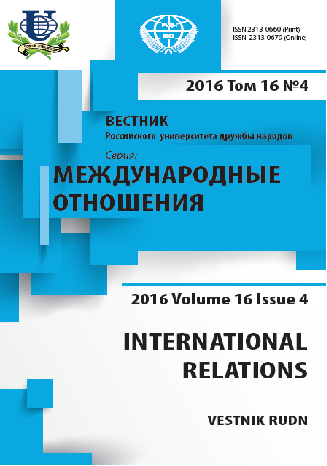An overview of contemporary Russian-Iranian relations
- Authors: Filin N.A.1, Ravandi-Fadai L.M.2, Burova A.N.3
-
Affiliations:
- Institute for African Studies of the Russian Academy of Sciences
- Institute of Oriental Studies of the Russian Academy of Sciences
- Russian State University for the Humanities
- Issue: Vol 16, No 4 (2016): Iran and India in the System of International Relations
- Pages: 677-687
- Section: Articles
- URL: https://journals.rudn.ru/international-relations/article/view/15441
- DOI: https://doi.org/10.22363/2313-0660-2016-16-4-677-687
Cite item
Full Text
Abstract
In post-Soviet period Russia and Iran have experienced quite a few sharp turns in bilateral relations. Periods of active dialogue alternated with long pauses, signing of multibillion-dollar contracts was replaced by the prosecution of both parties in default of its obligations and commitments. Geopolitical interests in this case take precedence over economic ones. The article describes the role of the Iranian issue in Russian-US relations, both within the Gore-Chernomyrdin Commission and concerning Iranian nuclear program. The question of the legal status of the Caspian Sea also affects bilateral relations. However, there are a number of objective factors that bring together country. Among them is a need to combat ethnic separatism as well as shock economic reforms started almost simultaneously in Russia and Iran in the early 1990s and led to an increase in social tension. Both countries are interested in maintaining peace and stability in the former Soviet republics of Central Asia, Caucasus and Afghanistan. In July 2005, Iran received observer status at the Shanghai Cooperation Organization (SCO). With the return to the post of Russian president Vladimir Putin in 2012, there has been improvement in Russian-Iranian relations. There has been a number of positive trends in trade and economic relations, implementation of joint economic projects.
About the authors
Nikita Alexandrovich Filin
Institute for African Studies of the Russian Academy of Sciences
Author for correspondence.
Email: nikitafilin@yahoo.com
Moscow, Russia
Lana Medzhidovna Ravandi-Fadai
Institute of Oriental Studies of the Russian Academy of Sciences
Email: ravandifadai@yahoo.com
Moscow, Russia
Anna Nikolaevna Burova
Russian State University for the Humanities
Email: burova-denjak@mail.ru
Moscow, Russia
References
- Arunova, M.R. (2004). Islamskaya revolyutsiya i rossiisko-iranskie otnosheniya [The Islamic Revolution and the Russian-Iranian relations]. Blizhnii Vostok i sovremennost', 21.
- Mamedova, N.M. (2012). Rossiya i Iran v kontse pervogo desyatiletiya KhKhI veka: protivorechiya i vzaimnye interesy [Russia and Iran at the end of the first decade of the twenty-first century: the contradictions and mutual interests]. Institut Blizhnego Vostoka. URL: http://www.iimes.ru/rus/stat/2012/21-03-12.htm (accessed: 13.06.2016).
- Trofimov, A. (2003). Analiz vzglyadov rukovodstva Irana na voenno-tekhnicheskoe sotrudnichestvo i perspektivy Rossii v regione [An analysis of the views of the Iranian leadership on military-technical cooperation and prospects of Russia in the region]. Institut izucheniya Izrailya i Blizhnego Vostoka. URL: http://www.iimes.ru/rus/stat/2003/10-04-03.htm (data obrashcheniya: 13.06.2016).
- Filin, N.A. (2012). Sotsial'no-istoricheskoe razvitie Islamskoi Respubliki Iran (1979-2008): faktory ustoichivosti gosudarstvennoi vlasti [Socio-historical development of the Islamic Republic of Iran (1979-2008): the factors of stability of state power]. Moscow.
- Karami, J. (2010-2011). Iran-Russia Relations: Expectations and Realities. An Iranian Quarterly, 9(3-4).
- Kozhanov, N. (2012a). Russia’s Reations with Iran: Dialog without Commitments. Washington: Washington Institute for Near East Policy.
- Kozhanov, N. (2012b). Russian-Iranian Economic Relations: Opportunities and Challenges. The Maghreb Review, 37(3-4).











